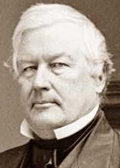 |
Millard Fillmore
b. 7 Jan 1800, Locke Township, Cayuga County, New York
d. 8 Mar 1874, Buffalo, New York |
| Title: |
President of the United States |
| Term: |
9 Jul 1850 - 4 Mar 1853 |
| Chronology: |
14 Feb 1849,
election to the office of Vice President of the United States is declared upon counting electoral votes (cast 6 Dec 1848),
joint session of the Senate and House of Representatives, House Chamber, U.S. Capitol, Washington, D.C. [1] |
|
4 Mar 1849,
commencement of term |
|
5 Mar 1849,
took the oath prescribed by law, special session of the Senate, Senate Chamber, U.S. Capitol, Washington, D.C. [2][3] |
|
9 Jul 1850,
entered upon the duties of the office of President of the United States upon the death of an incumbent [4] |
|
10 Jul 1850,
took an oath of office as President of the United States, joint session of the Senate and House of Representatives, House Chamber, U.S. Capitol, Washington, D.C. [5] |
|
4 Mar 1853,
expiration of term |
| Biography: |
| Reared on a farm; largely self-taught; apprenticed to a clothier; taught school in Buffalo while studying law; admitted to the bar in 1823 and commenced practice in East Aurora, New York; moved to Buffalo, New York, in 1830; member of the Assembly of the State of New York (1829-1831); elected as a Whig to the 23rd Congress (4 Mar 1833 - 4 Mar 1835); elected to the 25th, 26th, and 27th Congresses (4 Mar 1837 - 4 Mar 1843); declined to be a candidate for renomination in 1842; unsuccessful Whig candidate for Governor of New York in 1844; served as Comptroller of the State of New York (1847-1849); elected Vice President of the United States on the Whig ticket headed by Zachary Taylor in 1848, and was inaugurated on 4 Mar 1849; became President (9 Jul 1850 - 4 Mar 1853) upon the death of President Taylor; government enacted Clay's Compromise (1850), which sought to appease North and South on the slavery issue; federal enforcement of the Fugitive Slave Act of 1850 alienated the North and led to the death of the Whig Party; supported the provision requiring the federal government to aid in the capture and return of runaway slaves to their former owners; sent Commodore Matthew C. Perry with a U.S. fleet to Japan (1853); unsuccessful candidate for the Whig nomination for president in 1852; unsuccessful candidate for president on the National American ticket in 1856 (lost election to James Buchanan); commanded a corps of home guards during the Civil War; traveled extensively. |
| Biographical sources: Biographical Directory of the United States Congress (2005). |
| Elections: |
| Candidate |
Electoral vote (6 Dec 1848) |
| Millard Fillmore |
163 |
| William Orlando Butler |
127 |
| total number of electors appointed |
290 |
| number of votes for a majority |
146 |
|
| Source of electoral results: Congressional Globe, 30th Congress, 2nd Session, 534-535. |
| |
| [1] |
Congressional Globe, 30th Congress, 2nd Session, 534-535. |
| [2] |
Congressional Globe, 30th Congress, 2nd Session, Appendix, 326; Senate Executive Journal, vol. VIII, 64-65. |
| [3] |
Inauguration was postponed as 4 Mar 1849 fell on a Sunday. |
| [4] |
Congressional Globe, 31st Congress, 1st Session, 1363-1365. |
| [5] |
Congressional Globe, 31st Congress, 1st Session, 1365-1366. |
|
Image: photograph (created between 1855 and 1865). |